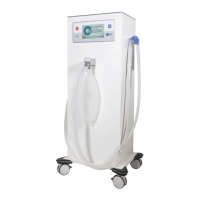– 26 –
a. May I touch the cylinders or pressure reducers
with cream on my hands?
No! Please keep them free of oil and grease.
b.
May I use a pliers to screw tight the pressure reducers?
No! Tightening by hand is sucient.
c. What happens if I unscrew the pressure reducers
before the system has been vented?
Nothing! You will not be able to twist them o while
there is still pressure is applied to them. The venting
instructions can be found in Section 6.
d. The nitrous oxide pressure reducer is ice-cold and
no more gas is owing!
The pressure reducer freezes up if too much nitrous oxide
is delivered over a long period of time. Close the nitrous
oxide and wait until the pressure reducer thaws out.
e. What happens if I give the patient too much ni-
trous oxide or oversedate him?
If the patient inhales too much nitrous oxide, he can
let you know as he is conscious. A nitrous oxide over
-
dose may cause nausea. In such an instance, reduce
the nitrous oxide and/or press the O
2
ush button.
f.
What happens if I mix up the pressure hoses?
If the hoses have been correctly manufactured, then
it is not possible to mix them up as the connectors
are dierent sizes.
g. The patient is nding it hard to breathe and does
not get sedated. What might be the reason?
Use the vacuum control block to check if the suction
is set too high.
h. Can I determine what percentage of nitrous oxide
a person needs based on their height and weight?
No. It is their lung volume that matters, not their
height and weight.
i. Why is nitrous oxide also known as laughing gas?
Because people used to be administered a 100%
dose of nitrous oxide at carnivals for fun, after which
they would stagger around the place comically. This
would make onlookers laugh.
j. Can I sedate a patient with a cold?
Yes, but only if you can clear their nasal passages us-
ing a nasal spray.
k.
Do I have to change the mask for every patient?
Yes. Each patient needs a new/autoclaved nasal mask.
Problem Possible cause Solution
Check O
2
information
signal ap-
pears
1. O
2
cylinder is not open.
2. The unit is not connected to the central gas
pipe system.
3. The O
2
cylinder is empty.
1. Open the O
2
cylinder.
2. Connection with wall connection.
3. Replace with full O
2
cylinder.
O
2
is owing,
but no N
2
O.
1. N
2
O cylinder closed.
2. N
2
O cylinder empty.
1. Open N
2
O cylinder.
2. Replace with full N
2
O cylinder.
N
2
O is owing,
but no O
2
.
Serious unit error. Do not use the unit any more and have it
checked.
The patient
is not feeling
the eects of
the sedation.
1. The mask is not positioned correctly on the
patient’s face.
2. The mixed gas is not ideally matched to the
patient's requirements.
3. Inner mask exhalation
membranes are defective/missing.
4. The inner mask is missing/not tting right.
1. Select another mask size/
press the mask softly to the face.
2. Increase the nitrous oxide concentration.
3. Replace membrane.
4. Insert inner mask
correctly.
The bag slack-
ens during
treatment.
1. The gas volume is not ideally matched to
the patient's needs.
2. The bag has a leak.
1. Increase the total ow
until the bag is full.
2. Contact your service partner and order a new bag.
The translation of this instruction of use is just
a service of Baldus Medizintechnik GmbH.
We do not guarantee for any translation errors.
INFORMATION

